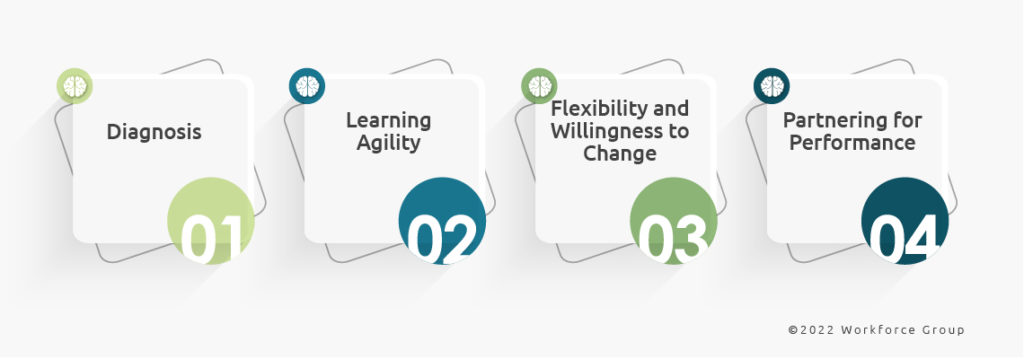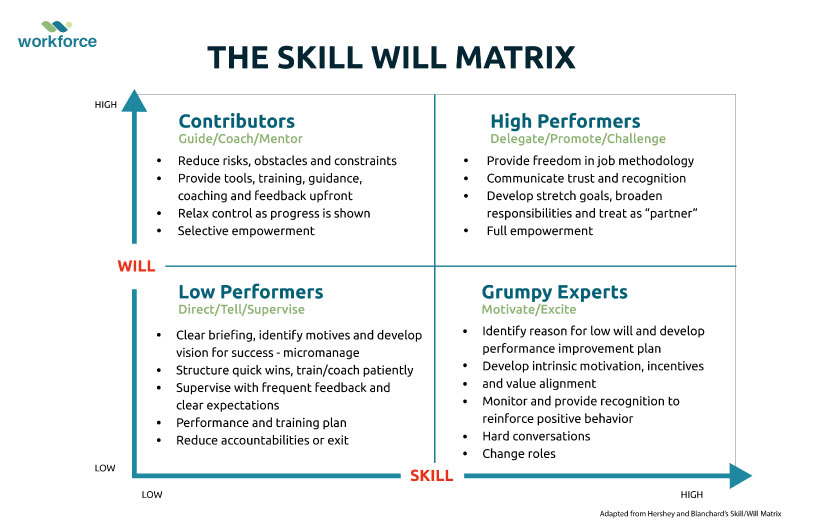There is no denying that managers play a critical role in employee engagement, productivity, and retention. Therefore, a manager’s leadership style and interaction with their team will directly impact performance and engagement.
A useful leadership framework I have shared with hundreds of leaders over the years is the Skill Will Matrix. It is a simple but powerful 2×2 performance management and employee engagement framework to help managers identify and adopt the most appropriate leadership approach for each team member and situation, based on two metrics: their Skill and Will (task and physiological maturity) levels. Skill relates to the individual’s capability and experience (core capability), while Will relates to motivation (willingness, enthusiasm and self-drive).
The matrix was derived from the Situational Leadership Model developed by Paul Hersey and Ken Blanchard in 1969, which is based on the study of relationships between leaders and followers and provides a useful framework to analyse leadership situations based on the performance readiness level that a follower exhibits in performing a specific task, function or objective.
This matrix operates on the assumption that there is “no one size fits all” leadership style. Rather, managers should evaluate an individual’s relative Will and Skill for a particular job or role then adapt their management styles to lead effectively, delegate, and empower them.
Hence, as managers, if we fail to evaluate the current state of our team members from a Skill and Will perspective, our leadership approach could negatively impact their performance.
Recommended Post: How to Build Leadership Capabilities for Successful Business Transformation
4 Skills Situational Leaders Must Have

For leaders to successfully adapt their management style to each unique situation or task in response to the needs of their team or team members, they must master four potent skills:
Diagnosis
Having the ability to observe and evaluate team members Skills and Will concerning a role, task or situation.
Learning Agility
They must have the agility to unlearn old ways and relearn new approaches. Leaders with high levels of learning agility seek out and learn from unfamiliar experiences and then apply those lessons to succeed in the next new unknown situation.
After reviewing thousands of senior executive assessments conducted across the world, Korn Ferry found that learning agility is now the single greatest predictor of executive success, above intelligence and education.
Flexibility and willingness to change
If leaders are to remain relevant and successful, they can no longer afford to rely on strategies that have worked in the past or even those that are working today. They must become comfortable with change and adopting a variety of leadership styles.
Partnering for Performance
Gaining direct reports’ confidence and cooperation to use the appropriate leadership style to match their Skill and Will levels.
Plotting Skill against Will provides four distinct quadrants that require different management responses. These styles of management range from directing the least skilful and willing individuals, up to delegating to the most skilful and willing individuals. The diagram below provides a detailed set of recommended actions to get the best from individuals across the four quadrants.

Four Quadrants of The Skill Will Matrix
High performers (delegate, promote and challenge them)
The High will and high skill. High performers are typically your shining stars and role model team members who can be delegated more responsibilities (asking them to deputise) and fully empowered.
This is where the business is going to get the best return on talent. Invest sufficient time to keep them engaged and growing to achieve their full potential. They should also mentor and train others.
Contributors (coach, guide and mentor them)
High will and low skill. Contributors or eager novices are often good-natured team members who need more training, mentoring and tools to improve their skills. While they have the desire and motivation for the role, they do not have the skills to meet the task or behavioural requirements.
Leaders should take a structured coaching and guiding approach with team members in this quadrant, ensuring that they have a specific development plan, with regular check-in points and reviews of skills attained and performance results.
They can typically be empowered for some accountabilities while necessitating more hands-on management for other accountabilities.
Good Read: Coaching as a Leadership Development Sustainability Tool
Grumpy Experts (motivate and excite them)
Low will and high skill. Grumpy experts or potential detractors have the skills to do a great job, but for whatever reason lack the will to put in their best effort. This is often common with team members who have been in their role for a while and feel that they are overdue a promotion.
Leaders need to take an exciting/supporting approach with individuals in this quadrant to encourage, inspire and ensure that behaviours are managed, and motivation levels are optimised, otherwise, they can often bring down entire team morale. But watch out, they could be backstabbers or silent/smiling assassins!
Low Performers (tell, direct and supervise them closely)
The Low will and low skill. Low performers are typically in over their heads in their current role and have a negative attitude towards their role and often the organization. They need to quickly improve their will and/or skill; otherwise, they should typically exit the organization.
The role of Leaders is therefore not to simply ‘write them off’ as problem/ disciplinary cases, but rather to conduct a root cause analysis into what the issues are and give them a chance to improve, with documented improvement expectations, clear feedback and direction. Low performers need to be highly directed on many of their accountabilities until their will or skill improves.
This is the one case where micromanagement may be necessary. They may also be in the wrong role so alternative job roles should be considered. The last resort is a move to exit.
The Skill Will matrix is a valuable framework and a starting point for determining the employee performance coaching requirements. It can uncover and bridge the skills gaps, improve utilisation of your team’s strengths and motivate them based on their values and preferences.
Framework Limitations
Like any other framework, the Skill Will Matrix isn’t without its limitations. A few that leaders should have in mind when using this leadership framework include:
- Managers’ constantly changing their approach to address the needs of individual team members could be confusing to their direct reports.
- Using this framework may incline managers to focus primarily on short-term goals at the expense of long-term goals.
- The framework presumes that leaders can determine an individual’s Skill and Will maturity levels. Unfortunately, some leaders are unable to do this effectively and may, therefore, adopt a style of leadership that does not suit a particular individual or team.
- There must be a good relationship (trust and respect) between the manager and direct report to create an environment to communicate and sell the intended management response to support the performance and developmental needs of the direct report.
- This approach may not be ideal when repetitive tasks need to be completed, as this leadership approach requires flexibility that many task-driven environments may lack.
The next time you have to make a leadership decision, it may be worthwhile to avoid adopting a “one size fits all approach” to every member of your team or situation. Instead, evaluate the situation (the Skill and Will of the individual(s)), then adapt your approach to the style that is most likely to deliver the desired outcome/results.
To succeed in today’s complex and rapidly changing business world, leaders must be adaptable, resilient and open to innovative thinking. The best performing organisations have leaders who thrive on change and can make sense of uncertainty. They continually evaluate their evolving situation/environment and adapt or risk failing.
I hope you find the framework useful.

